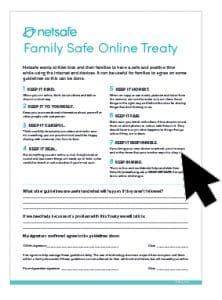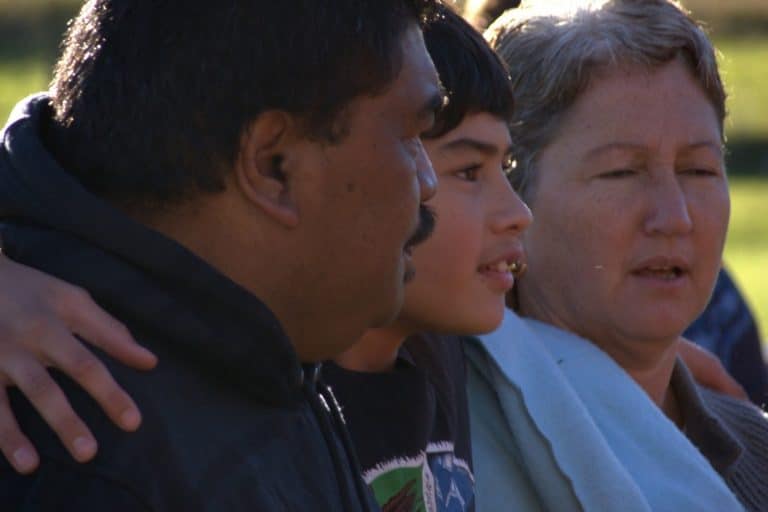How to create an online safety plan
It can be difficult to know where to start when thinking about keeping your children safe online. This is why Netsafe created the Family Safe Online Treaty to help all kids and their families to have a safe and positive time while using the internet and devices. Read our advice to get started. Family Safe…

It can be difficult to know where to start when thinking about keeping your children safe online. This is why Netsafe created the Family Safe Online Treaty to help all kids and their families to have a safe and positive time while using the internet and devices. Read our advice to get started.
Family Safe Online Treaty
Netsafe has created the Family Safe Online Treaty to help young people have better online experiences. The Treaty has been designed to help you have early, and ongoing, conversations about ways to stay safe and to have a plan on what you’d do if something went wrong. We know this is one of the best ways to navigate online challenges.
To get started read our five steps and download the Family Safe Online Treaty that best matches the age of your child, and then sit down with the family to agree on what you will do. It might also be useful to read our Online Safety Parent Toolkit as it offers practical tips and tools that will help you talk to your child about online safety. It includes:
- Quickstarter tips for parents, whānau and young people
- Information to enhance your digital parenting knowledge
- Details about the online risks and challenges your child may face
- Advice about how you can help your child
Step 1. Figure out what they know already
The best place to start the conversation is by figuring out what your child knows already. Talk to them about issues they’ve seen happen to friends or at school and use this as a basis for your discussions with them. Ask them what advice they would give to their friend if they ran into trouble online as this can be a good way to gauge their understanding. Use these discussions as the starting point for the plan you develop together.
Step 2. Let them know that you will support them no matter what
Research shows that many young people feel they would rather speak to a friend than a parent or other trusted adult for fear of being judged. It’s important to let them know that they can talk to you about anything and that you will be there to support them no matter what.
Step 3. Talk about who they can reach out to if they need help
If something does go wrong online it’s important that your child speaks to someone about it. Discuss who might be appropriate for them to speak to if they need help. This could be you, a close friend, a trusted family member, a teacher or a support service such as Netsafe.
It’s also a good idea to talk about who they would talk to if they didn’t feel comfortable talking to you, that way you know whatever goes wrong they know who they can go to for help and support.
Step 4. Discuss ways to report or remove harmful content
Most social media sites have a ‘report’ function to allow people to report content that is in violation of their terms of service. Make sure your child knows how to block someone, report content and how to use their privacy settings.
If you or your child need help removing harmful content online you can contact Netsafe for help. We can offer help for all situations – big or small.
In some cases online content may violate the Harmful Digital Communications Act. If you think a digital communication is in violation of the act contact Netsafe.
Step 5. Have emergency contact details on hand in case you need it
As a parent it can be hard to think about things going very wrong for your child online. In case of an urgent situation it’s worth having an understanding of what services are available and when you should contact them just in case. We’ve put together a list of services you can turn to if you or your child need help.
- Police – Call 111. If your child is in risk of imminent danger or a crime is being committed contact 111 immediately for help.
- Netsafe – Call 0508 NETSAFE (0508 638 723), email [email protected] or report online. Netsafe can provide help and support with online challenges including online bullying, harassment and abuse.
- Youthline – Call 0800 376 633, Free TXT 234 or email [email protected]. Youthline provides a free counselling service for young people.
- Lifeline Suicide Crisis Helpline – 0508 TAUTOKO (0508 828 865). A free 24 hour suicide crisis helpline operated by trained counsellors.
- Need to Talk – Free text or call 1737. A free 24 hour call or text help line operated by trained counsellors.
- Department of Internal Affairs – Digital Child Exploitation Team
- WellStop (Wellington) – Make a referral online. A service to prevent sexual abuse by providing support for concerning or harmful sexual behaviour.
- SAFE Network (Auckland) – 09 377 9898 ext 700 or make a referral online. A service to prevent sexual abuse by providing support for concerning or harmful sexual behaviour.
- STOP (Christchurch) – 03 353 0257 or [email protected]. A service to prevent sexual abuse by providing support for concerning or harmful sexual behaviour.
- Help (Auckland) – 09 623 1700 or [email protected]. A free 24 hour helpline to support victims of sexual assault.
- What’s Up – 0800 942 8787 or via online chat. A free helpline service to support children and teens.
- Kidsline – 0800 KIDSLINE (0800 54 37 54). A free helpline service to support children.
- Rape Prevention Education – Contact online. Provides education and information to prevent sexual violence.
- Shine – 0508 744 633. A free helpline to provide support to people who have been victims of family violence.
- Ministry for Vulnerable Children – Oranga Tamariki – 0508 326 459 or [email protected]
Government agency responsible for protecting children. - The Parenting Place – 0800 53 56 59. Support service providing parenting advice.
Keep up to date
Follow us on social media and sign up to our enewsletter for alerts, news and tips.


![]()






